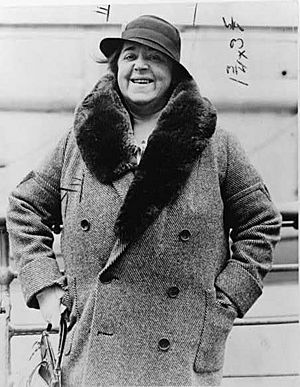Elsa Maxwell facts for kids
Quick facts for kids
Elsa Maxwell
|
|
|---|---|

Maxwell photographed by Carl van Vechten in 1935
|
|
| Born | May 24, 1883 Keokuk, Iowa, U.S.
|
| Died | November 1, 1963 (aged 80) New York City, U.S.
|
| Occupation | Gossip columnist, author, songwriter, hostess, screenwriter, radio personality |
Elsa Maxwell (born May 24, 1883 – died November 1, 1963) was a famous American party planner. She was known for throwing amazing parties for important people like royalty. Elsa was also a writer, songwriter, and worked on the radio and in movies.
She helped make games like the scavenger hunt popular for parties. Elsa had her own radio show called Elsa Maxwell's Party Line starting in 1942. She also wrote a newspaper column where she shared news about famous people. You might have seen her in movies like Stage Door Canteen (1943) and Rhapsody in Blue (1945). She even helped write a movie called Hotel for Women (1939).
Contents
The Life of Elsa Maxwell
Elsa Maxwell was born in Keokuk, Iowa. She grew up in San Francisco, California. Her father taught her at home, so she did not go to regular school.
Elsa became interested in parties when she was 12. She was told she couldn't go to a party because her family wasn't rich. This made her want to create her own fun. She became very good at planning unique games and activities for parties. She even made a living by creating special treasure hunts and other themed parties. In 1927, she organized a scavenger hunt in Paris that caused quite a stir!
Party Planning and Famous Friends
In the early 1920s, Elsa helped make Venice, Italy, a popular place for stars. She brought famous people like Cole Porter and Noël Coward to the Lido beach. Later, the country of Monaco hired her to help attract tourists.
Elsa and Cole Porter were good friends for life. He even mentioned her in some of his songs. Other famous songwriters also included her name in their music.
When Elsa returned to the U.S., she worked on short films. The famous Waldorf Astoria hotel in New York gave her a free suite in 1931. They hoped her presence would attract other rich guests. After World War II, millions of people read her newspaper column. Her radio show, Elsa Maxwell's Party Line, also became very popular.
Elsa Maxwell helped the ventriloquist Edgar Bergen become famous. Bergen had been performing for many years without much success. He kept calling Elsa until she agreed to meet him and his puppet, Charlie McCarthy. Elsa was very impressed. She helped Bergen get a spot on a popular radio show, which launched his career.
Later Years and Friendships
Elsa Maxwell had a long friendship with the Scottish singer Dorothy Fellowes-Gordon. They met in 1912 and stayed together until Elsa's death.
In the 1950s, Elsa became good friends with the Duke of Windsor and Wallis Simpson, the Duchess of Windsor. They often spent time together in France and at Elsa's parties around the world. There were some stories in the newspapers about a disagreement between Elsa and the Duchess. However, they later made up.
Elsa also took credit for introducing actress Rita Hayworth to Prince Aly Khan in 1948. She was also said to have introduced opera singer Maria Callas to Aristotle Onassis.
Elsa Maxwell passed away from heart failure in New York City. Her last public appearance was at the annual April in Paris Ball, which she helped create. She was buried in Ferncliff Cemetery in New York.
Films Elsa Maxwell Appeared In
Elsa Maxwell played herself in most of these movies.
- Hotel for Women (1939) as Mrs. Tilford
- Public Deb No. 1 (1940)
- The Lady and the Lug (1941) (a short film)
- Throwing a Party (1941) (a short film)
- Stage Door Canteen (1943)
- Rhapsody in Blue (1945)
- Main Street to Broadway (1953)
Images for kids
See also
 In Spanish: Elsa Maxwell para niños
In Spanish: Elsa Maxwell para niños



